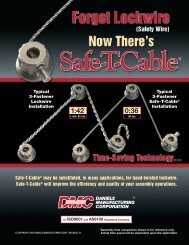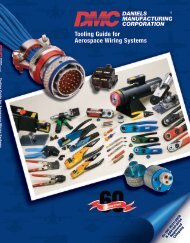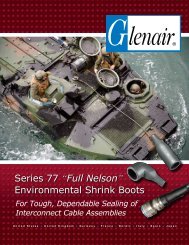High-Performance Micro-D Connectors and Cables - Pan Pacific ...
High-Performance Micro-D Connectors and Cables - Pan Pacific ...
High-Performance Micro-D Connectors and Cables - Pan Pacific ...
- No tags were found...
Create successful ePaper yourself
Turn your PDF publications into a flip-book with our unique Google optimized e-Paper software.
Not All <strong>Micro</strong>-D’sAre Created EquallyThe MIL-DTL-83513 <strong>and</strong> MIL-DTL-32139 specifications define the minimum acceptable performance levelsfor <strong>Micro</strong>-D <strong>and</strong> Nanominiature connectors. While the specs are rigid in their performance benchmarks,manufacturers are given considerable leeway when it comes to contact design, crimp fabrication, contact finish<strong>and</strong> material selection. Stamped <strong>and</strong> formed contacts, for example, are widely used in <strong>Micro</strong>-d connectors dueto their low-cost <strong>and</strong> ease of manufacture. But independent testing clearly shows that TwistPin style contactsprovide superior performance in such areas as high temperature tolerance, contact retention <strong>and</strong> crimp strength.If you have already made the decision to use either a <strong>Micro</strong>-D or Nano sized connector because its ruggedizedperformance outweighs the potential cost-savings realized in a lesser-caliber connector, then you owe it to yourselfto underst<strong>and</strong> the very real differences between stamped pins <strong>and</strong> the Glenair TwistPin Contact System.StampedPin“B” CrimpWith SpotWeldGlenairTwistPin8 Indent Mil SpecCrimp JointSplit-Tine Contact SystemsThe socket contact is made bymachining a copper alloy tube, thencutting a longitudinal slot. The contactis then crimped to bend the tinestogether. The smallest split tinecontact systems are used inconnectors with .075 inchspacing. The TwistPinoffers improved vibrationperformance <strong>and</strong> highercontact density.M39029 Split TineContact SystemTwo Reasons to Choose TwistPinsThis unretouched photograph shows important differences between theTwistPin <strong>and</strong> stamped pins.1A Better Crimp Joint<strong>Micro</strong>-D connectors are factory-terminated to wire. Board mount <strong>and</strong>insulated wire pigtails have crimp joints where the wire attaches to thecontact. <strong>Micro</strong>-D crimp joints are concealed with epoxy potting. The <strong>Micro</strong>-Dis unique among high reliability mil spec connectors because the mil specallows stamped crimp barrels <strong>and</strong> does not specify that the crimping processmust use mil spec crimp tools. The thin sheet metal in the stamped pincannot produce a satisfactory gas-tight crimp joint, so spot welding is requiredto reduce the chance of failure.A Stronger Front End2 Both types of contacts meet the requirements of MIL-DTL-83513. Butonly the TwistPin offers a stronger front-end with its seven points of contact,high normal force <strong>and</strong> better resistance to vibration.Seven Points of ElectricalContactThe TwistPin size #24 contacthas seven str<strong>and</strong>s of BeCu wiresurrounding three filler str<strong>and</strong>s .Each str<strong>and</strong> makes contact withthe socket, assuring low resistance,plenty of contact wipe, <strong>and</strong> excellentshock <strong>and</strong> vibration performance.© 2011 Glenair, Inc. CAGE Code 06324Printed in U.S.A.GLENAIR, INC. • 1211 AIR WAY • GLENDALE, CA 91201-2497 • 818-247-6000 • FAX 818-500-9912www.glenair.comIntro-5E-Mail: sales@glenair.com









